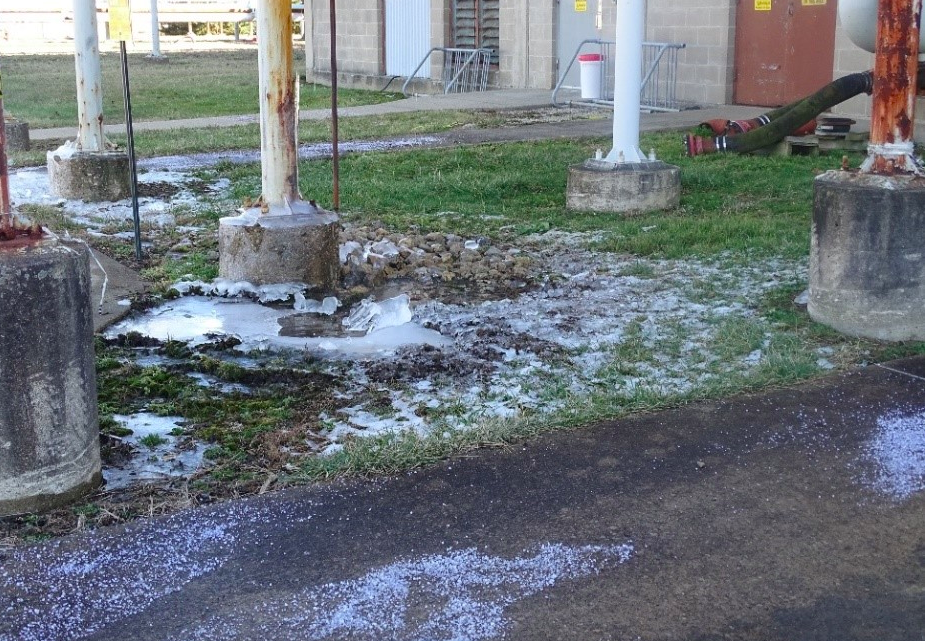Lessons Learned: Situational Awareness

Situational awareness and changing conditions must be continuously evaluated.
Utility maintenance or the lack thereof can introduce new hazards, and even those who are accustomed to responding to inclement weather conditions must be vigilant in identifying hazardous conditions, exercising situational awareness.
On the surface, general grounds maintenance activities, including periodic snow and ice removal services, appear to be routine low-risk work. However, based on several variables or changing conditions with unique outdoor exposure risks, these activities can quickly become much more complex if unexpected risks are introduced, especially without situational awareness. When it comes to snow and ice removal, grounds maintenance personnel are the first responders to know hazardous conditions.
Grounds maintenance personnel are relied upon to treat the roads and walkways to help assure the safety of everyone else. Without the efforts of grounds maintenance personnel, the number of personnel who could be injured would exponentially increase.
Situational awareness and changing conditions must be continuously evaluated.
Utility maintenance or the lack thereof can introduce new hazards, and even those who are accustomed to responding to inclement weather conditions must be vigilant in identifying hazardous conditions. Discussion DOE sites have grounds maintenance work scope that generally involves various outdoor exposure risks including, but not limited to: snow and ice removal/treatment, temperature extremes, various equipment risks, potential overhead roof snow and ice hazards, arboricultural/tree falling, and/or downed power lines.
These activities have inherent risks and must be recognized and controlled to assure associated hazards are identified, controlled, and mitigated, both for internally performed work scope as well as any external or subcontracted work scope.
Grounds maintenance personnel are the first responders to know hazardous inclement weather conditions as they treat the roads and walkways to help assure the safety of everyone else. Without the efforts of grounds maintenance personnel, the number personnel who could be exposed to slippery conditions and likely be injured would be exponentially increased.
Situational awareness in action, after a fall
NWD reviewed a recent slip and fall injury involving grounds maintenance personnel. The inclement weather event was concluded and the grounds maintenance personnel were refilling salt receptacles. While conducting this work, one of the grounds maintenance personnel was walking toward one of the salt receptacles on what appeared to be a wet surface, and did not anticipate a fully ice-covered walkway. The unexpected ice-covered walkway resulted in a slip and fall, incurring an injury to the wrist.
The walkway in question was on the shaded, north facing side of a two story 30-foot high facility with a steam line running parallel with the walkway. The combination of the poor placement of the steam trap and associated steam leaks in close proximity to the walkway, and the previous night’s colder temperatures, resulted in the buildup of one or more inches clear ice.
The warmer temperature on the next day during the work activity slightly melted the surface of the ice making the surface appear wet rather than ice covered. The routine nature of the work and the seemingly safe appearance of the surface lulled the worker into proceeding without applying optimum situational awareness regarding the changing conditions taking place around them.
Analysis
Snow and ice hazards and controls must be assessed during changing weather conditions. Hazards created by other site contractors’ seemingly inconsequential systems, such as steam and utility lines that may have water leaks, must be recognized and controlled.
Unidentified, these hazards can expose grounds maintenance and site personnel to additional risks. In this case, the poorly maintained utility system leaks posed a significant ice buildup hazard, that left un-regarded in maintenance and situational awareness planning resulted in an avoidable injury. To ensure the safety of all site personnel, it is important to control the risks and hazards to the first responders, the frontline grounds maintenance personnel.
Poorly maintained utility systems must be considered in situational awareness planning, as they pose unique hazards and risks particularly during freezing weather conditions.
Recommended Actions
NWD took the following actions following the recent incident: 1) 2) 3) 4) 5) 6) 7) Established a boundary to the walkway area in question. Requested the Site Contractor/Facility Manager to enter a Work Order Request to repair steam line leaks and reconfigure the steam trap discharge as not to impact a hazard to the walkway. Conducted an extent of condition for like utility hazard impacts and northern facing walk areas. Continue to re-evaluate and define the scope of work regarding the complexity and risks that are inherent to grounds maintenance operations. Continue to identify and analyze the hazards associated with operations as well as introduced hazards. Re-evaluate, develop, and implement hazard controls that utilize proven industry techniques to mitigate hazards, including the use of mechanical engineered equipment when feasible. Reassure any subcontracted grounds maintenance work scope has been evaluated and hazards are controlled, evaluated, and verified.
8) 9) 10) Perform grounds maintenance operations work scope within established controls including the use of mechanical engineered equipment when feasible. Apply enhanced situational awareness as part of feedback and continuous improvement efforts. Review and share feedback and Lessons Learned.
Content/image source: DOE OPEXshare, Dept. of Energy, “Continuous Situational Awareness is Key to Avoiding Slips and Falls on Snow or Ice,” March 25, 2024.
Would you like to become TapRooT® Trained? Register for a TapRooT® course to put yourself on the best career path to skills development and effective training in troubleshooting to identify the root causes of issues and incidents.
TapRooT® Trained professionals have the training and skillsets necessary for investigation, problem-solving, and root cause analysis.



